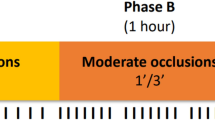Abstract
Objective
To investigate the effect of total umbilical cord occlusion on cerebral arteriovenous difference for nitrite (a stable end product of nitric oxide) and neuronal outcome.
Method
The cord was totally occluded for 10 minutes in 14 late-gestation (gestational age 113-120 days) chronically instrumented fetal sheep. Arterial (carotid artery) and venous (superior sagittal sinus) blood samples were taken at regular intervals for determination of acid-base status, glucose, lactate, and nitrite plasma levels. Three days after the occlusion period the fetal brain was perfusion fixed, and the parietal cortex, hippocampus, and cerebellum were scored for neuronal damage.
Results
Three fetuses died shortly after the occlusion period. Total umbilical cord occlusion resulted in a combined respiratory and metabolic acidosis as observed in carotid arterial blood gas samples (pH, 6.96 ± 0.02; CaO2 [mmol/L], 0.43 ± 0.9; Paco2 [kPa], 13.46 ± 0.38; base excess [mmol/L], -11.1 ± 0.8; lactate [mmol/L], 10.57 ± 0.95; bradycardia, 75 ± 9 bpm; and hypotension, 29.85 ± 3.00 mmHg) (n = 14, values are mean ± standard error of the mean). Selective brain damage was observed in the hippocampus in 10 of the 11 surviving fetal sheep. No changes in arterial, venous, or cerebral arteriovenous difference for nitrite plasma levels were observed (n = 11).
Conclusion
Total umbilical cord occlusion of 10 minutes in preterm fetal sheep results in hippocampal damage but not in changes of cerebral arteriovenous difference for nitrite plasma levels, a stable end product of nitric oxide.
Similar content being viewed by others
References
Moncada S, Palmer RMJ, Higgs EA. Nitric oxide: Physiology, pathophysiology, and pharmacology. Pharmacol Rev 1991;109–42.
Hamada Y. Hayakawa T, Hattori H, Mikawa H. Inhibitor of nitric oxide synthesis reduces hypoxic-ischemic brain damage in the neonatal rat. Pediatr Res 1993;35:10–14.
Trifiletti RR. Neuroprotective effects of NG-nkro-L-arginine in focal stroke in the 7-day-old rat. Eur. J. Pharmacol 1992;218:197–8.
Huang ZH, Huang PL, Panahian N, Dalkara T, Fishman MC, Moskowitz MA. Effects of cerebral ischemia in mice deficient in neuronal nitric oxide synthase. Science 1994;265:1883–5.
Tan WKM, Williams CE. During MJ. et al. Accumulation of cytotoxins during the development ot seizures and edema after hypoxic-ischemic injury in the late-gestation fetal sheep. Pediatr Res 1996;39:791–7.
Mallard EC, Gunn AJ. Williams CE, Johnston BM, Gluckman PD. Transient umbilical cord occlusion causes hippocampal damage in the fetal sheep. Am J Obstet Gynecol 1992;17:1423–30.
Beckman JS. The double-edged role of nitric oxide in brain function and superoxide-mediated injury. J Dev Physiol 1991;53–9.
Kumura E, Kosaka H, Shiga T, Yoshimine T, Hayakawa T. Elevation of plasma nitric oxide end products during focal cerebral ischemia and reperfusion in the rat. J Cereb Blood Flow and Metab 1994;14:487–91.
de Blaauw I, Deutz NE, van der Hulst RR, von Meyenfeldt MF. Glutamine depletion and increased gut permeability in nonanorectic, non-weight-losing tumor-bearing rats. Gastroenterology 1997;112:118–26.
Misko, TP. A fluorometric assay for the measurement of nitrite in biological samples. Anal Biochem 1993;214:11–6.
Ikeda T, Murata Y, Quilligan EJ, et al. Physiologic and histologic changes in near-term fetal lambs exposed to asphyxia by partial umbilical cord occlusion. Am J Obstet Gynecol 1998;178:24–32.
Keunen H, Blanco CE, Van Reempts JLH, Hasaart THM. Absence of neuronal damage after umbilical cord occlusion of 10, 15 and 20 minutes in midgestation fetal sheep. Am J Obstet Gynecol 1997;176:515–20.
Mallard EC, Gunn AJ, Williams CE, Johnston BM, Gluekman PD. Increased vulnerability to neuronal damage following umbilical cord occlusion in the fetal sheep with advancing gestation. Am J Obstet Gynecol 1994;170:206–14.
Wagner KR, Ting P, Westfall MV, Yamaguchi S, Bacher JD, Myers RE. Brain metabolic correlates of hypoxic-ischemic cerebral necrosis in mid-gestational sheep fetuses: Significance of hypotension. J Cereb Blood Flow Metab 1986;6:425–34.
Ball RR, Parer JT, Caldwell LE, Johnson J. Regional blood flow and metabolism in ovine fetuses during severe cord occlusion. Am J Obstet Gynecol 1994;171:1549–55.
Richhardson BS, Carmichael L, Homan J, Johnston L, Gagnon R. Fetal cerebral, circulatory, and metabolic responses during heart rate decelerations with umbilical cord compression. Am J Obstet Gynecol 1996;175:929–36.
Voorhies TE, Rawlinson D, Vannucci RC. Glucose and perinatal hypoxic-ischemic brain damage. Neurology 1986;36:1115–8.
Pulsinelli WA, Waldman S, Rawlinson D, Plum F. Moderate hyperglycemia augments ischemic brain damage: A neuropatho-logical study in the rat. Neurology 1982;32:1239–46.
Ignarro LJ, Fukuto JM, Griscavage JM, Rogers NE, Byrns RE. Oxidation of nitric oxide in aqueous solution to nitrite but not nitrate: Comparison with enzymatically formed nitric oxide from L-arginine. Proc Natl Acad Sci U S A 1993;90:8103–7.
Kader A, Frazzini VI, Solomon RA, Trifiletti RR. Nitric oxide production during focal cerebral ischemia in rats. Stroke 1993;24:1709–16.
Williams CE, Gunn AJ, Mallard EC, Gunning MI, Gluekman PD. Outcome after ischemia in the developing sheep brain: An electroencephalographic and histological study. Ann Neurol 1992;31:14–21.
Northington FJ, Tobin JR, Harris AP, Traystman RJ, Koehler RC. Developmental and regional differences in nitric oxide synthase activity and blood flow in the sheep brain. J Cereb Blood Flow Metab 1997;17:109–15.
Giuili G, Luzi A, Poyard M, Guellaen G. Expression of mouse brain soluble guanylyl cyclase and NO synthase during ontogeny. Dev Brain Res 1994;81:269–83.
Ferriero DM, Arcavi LJ. Sagar SM, McIntosh TK, Simon RP. Selective sparing of NAPDH-diaphorase neurons in neonatal hypoxia-ischemia. Ann Neurol 1988;24:670–6.
Author information
Authors and Affiliations
Corresponding author
Additional information
This work was supported by the University Maastricht Research Fund.
Rights and permissions
About this article
Cite this article
Keunen, H., Deutz, N.E.P., Van Reempts, J.L.H. et al. Transient Umbilical Cord Occlusion in Late-Gestation Fetal Sheep Results in Hippocampal Damage but Not in Cerebral Arteriovenous Difference for Nitrite, a Stable End Product of Nitric Oxide. Reprod. Sci. 6, 120–126 (1999). https://doi.org/10.1177/107155769900600302
Published:
Issue Date:
DOI: https://doi.org/10.1177/107155769900600302



